The AMD Radeon R9 380X Review, Feat. ASUS STRIX
by Ryan Smith on November 23, 2015 8:30 AM EST- Posted in
- GPUs
- AMD
- Radeon
- Asus
- Radeon 300
Overclocking
Finally, no review of a video card would be complete without a look at overclocking performance.
With ASUS setting the STRIX R9 380X’s factory clockspeed to 1030MHz – 60MHz ahead of AMD’s reference clock of 970MHz – ASUS is already significantly eating into the headroom available on the card, and the 1050MHz OC mode further cuts into that. We don’t have any voltage control (we can’t even read the voltage) so the card can only be overclocked as far as the Tonga GPU can go on default voltage. Meanwhile ASUS hasn’t touched the memory clockspeed at all, which should mean there’s a bit more headroom there to play with.
| ASIS STRIX R9 380X Overclocking | ||||
| ASUS STRIX R9 380X OC (Stock) | ASUS STRIX R9 380X (OC) | |||
| Boost Clock | 1030MHz | 1100MHz | ||
| Memory Clock | 5.7Gbps | 6.4Gbps | ||
| Power Limit | 100% | 115% | ||
Ultimately we were able to push the STRIX R9 380X OC from 1030MHz to 1100MHz on the GPU, a 70MHz (7%) overclock. I fully expect that Tonga could do better with more voltage – and the ASUS cooler could keep up – but at the same time it would take a bad power efficiency situation and make it worse. Otherwise memory overclocking was a bit more fruitful, as we were able to push the card from 5.7Gbps to 6.4Gbps, a 700Mbps (12%) performance increase. Note that relative to the original 7970, the R9 380X has a narrower 256-bit memory bus, so if there are any situations where GCN 1.2’s color compression technology can’t make up the difference, a memory overclock may help to close the gap.
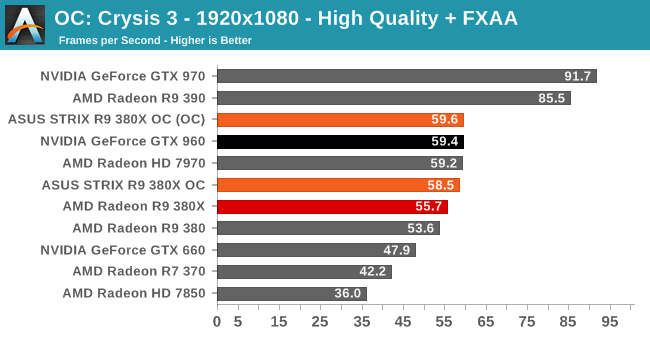
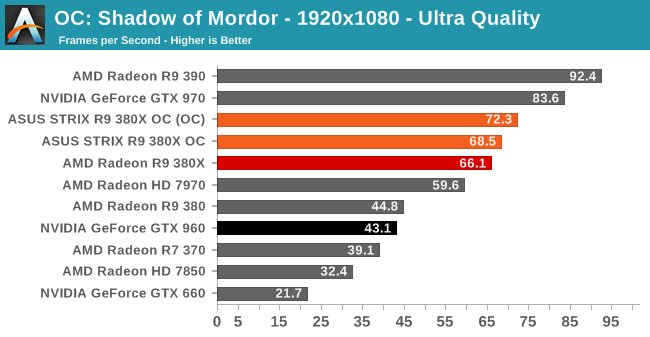
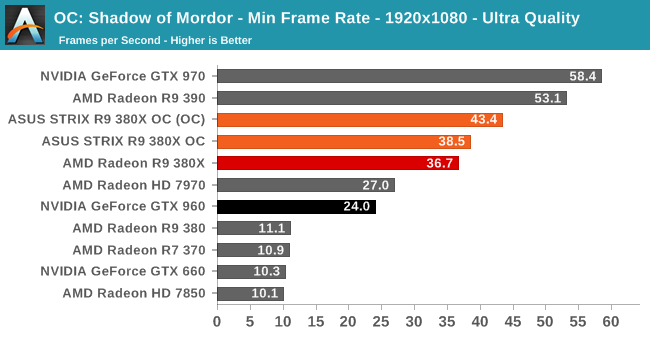
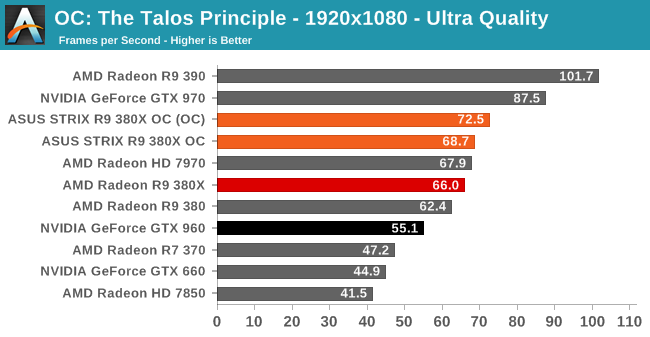
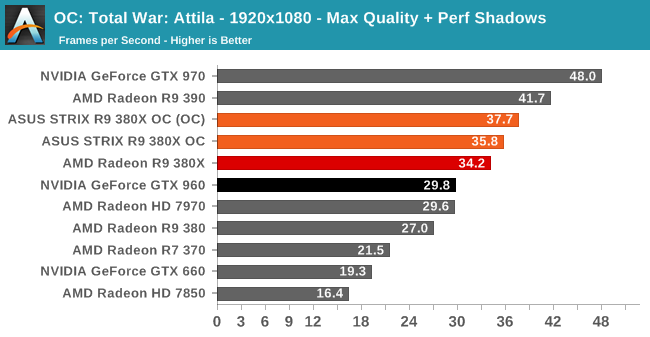
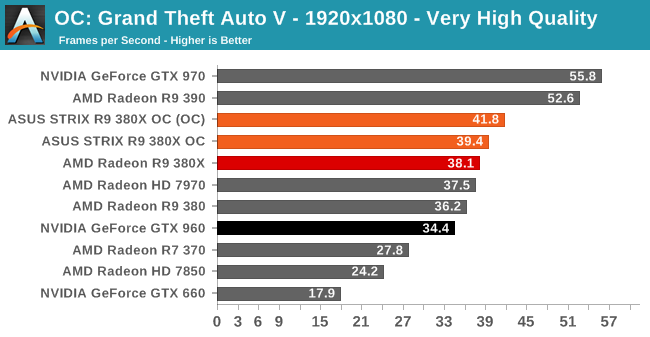
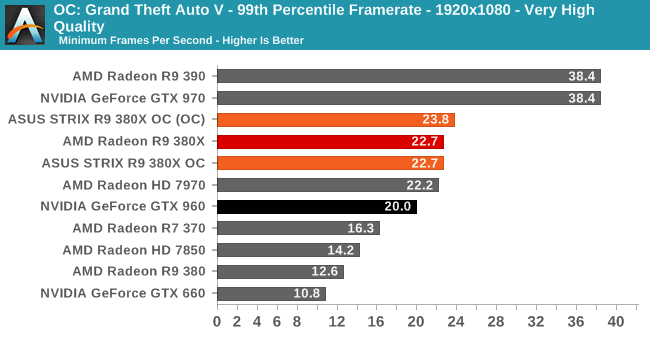
Overall overclocking is good for another 5% performance increase over the STRIX R9 380X's factory overclock. Though enough to be significant, as we guessed base upon the clockspeeds, ASUS has already tapped much of the overclocking headroom available on the card. For reference clocked cards on the other hand, assuming that they can overclock similarly well, this means they can look forward to a total of 10% or so from overclocking.
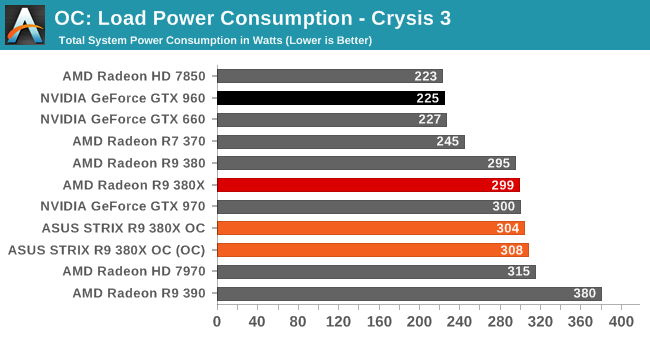
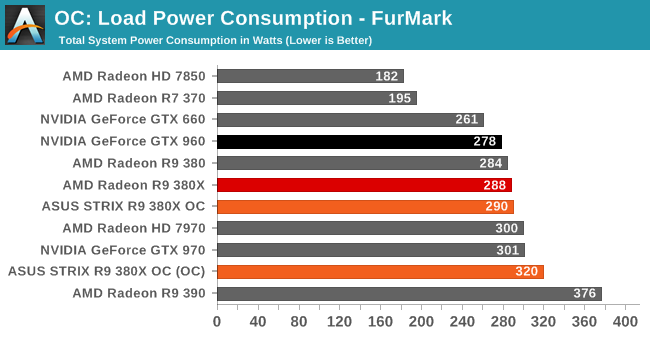
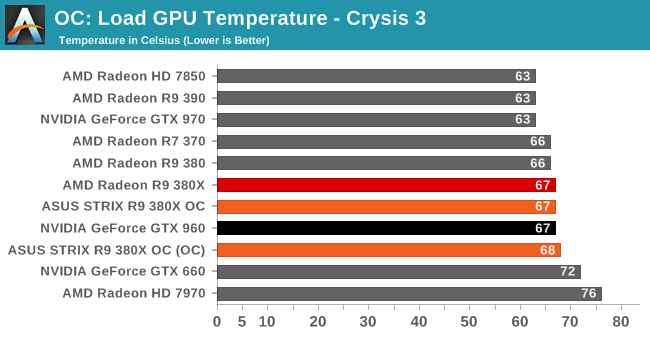
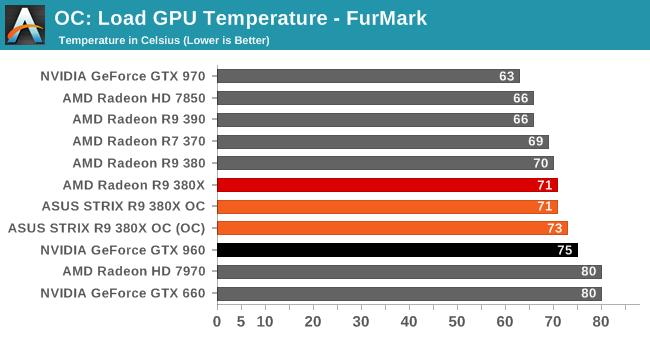
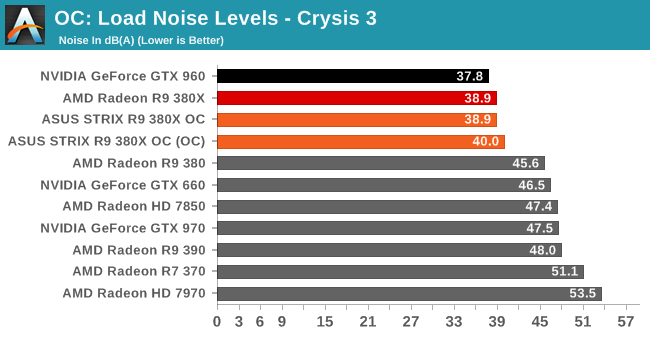
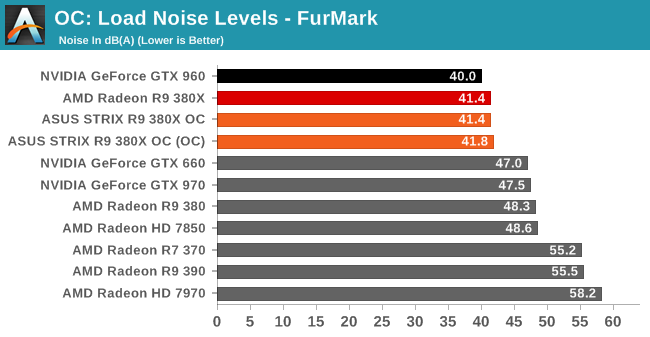
Since we can't overvolt, the power/temp/noise impact of overclocking is limited. Under gaming workloads the difference is a handful of watts and a nothing for temperature or noise. Otherwise FurMark, with the higher power target, pushes the STRIX card a bit harder, but everything still remains within reason.










101 Comments
View All Comments
Asomething - Tuesday, November 24, 2015 - link
The HSA foundation is partially founded by ARM which means they are already working on it (but as you said there isnt much motivation to make HSA enabled apps). AMD is the only high profile and headline grabbing member of it so they tend to get the most press because of clickbait articles. And a lot (if not all) of nvidia's efficiency improvements do come from the lower transistor density (also the main reason they can say their TDP is so low since the chip has a larger surface area with which to dissipate the same amount of heat as the same chip made using AMD's high density libraries would have), improvements to the memory and reductions in DP capabilities.tamalero - Tuesday, November 24, 2015 - link
anyone can explain me why everyone says the new gpus are overpriced?their pricepoints seems to be similar to the performance of the nvidia cards.
the table on the first page shows clearly.
Even the review shows the 970 and the AMD 390 trading blows and have the same price point.
so, what did I miss? why suddenly fanboys demand even 15% reduction to "become competitive" ?
FriendlyUser - Tuesday, November 24, 2015 - link
As everyone has noted, the cards are uncomfortably close to the higher tier (390 and 970). So, the 380X is not overpriced with respect to the competition from nvidia, but with respect to the 390. The jump in performance is so great, that we should either hope the 390 goes at $300 (practically eliminating the 380X) or the 380X completely dominates the sub-200 territory.Anyway, overall it's a very good product.
just4U - Friday, November 27, 2015 - link
Well.. here in Canada that's not quite the case. A 380/960 /w 4G mem sells for 300ish.. the 380X $330.A 970 runs you $450-500 and a 390 $430+ No way their priced similar to the 970/390.
BurntMyBacon - Tuesday, November 24, 2015 - link
@Samus: "They need to drop the prices across the entire line about 15% just to become competitive."That wouldn't fix the biggest pricing problem shown in this review. The 380X is priced too closely to the 390 given the performance difference. Drop them both by 15% and the 380X is still priced too closely to the 390. I'll leave the rest of you to argue performance vs premium cooler value on the high end and 390/390X vs GTX970/GTX980 performance per dollar, but I submit that a flat 15% drop is too simple an answer to the problem due to competition within their own lineup.
Azix - Wednesday, January 13, 2016 - link
but people were fine with the 960 at the same price...zeeBomb - Monday, November 23, 2015 - link
Ryan smith blessed us with a great graphics card review.maecenas - Monday, November 23, 2015 - link
At this point, NVIDIA or AMD, I'm not sure I would get anything other than an ASUS cooling system. I have the STRIX version of the GTX 970 and it really is fantastic.jasonelmore - Monday, November 23, 2015 - link
It Depends on what you need. The Stock Blower Coolers keep hot air out of the case, so for Small Form Factor Builds, your not going to want Asus's coolers since they dump the hot air back into the case.theduckofdeath - Tuesday, December 1, 2015 - link
I have a mATX case with water cooling and internal padding all around to keep the noise down, and my ASUS Strix GTX 960 is not making a sound and the temp in the case does not go above 50-52 degrees celsius even after hours of playing. The problem with GPUs sucking air out from the rear and blowing the same air out is, they have to generate all of the airflow themselves, which always gets really noisy compared to using the air passing through a case.